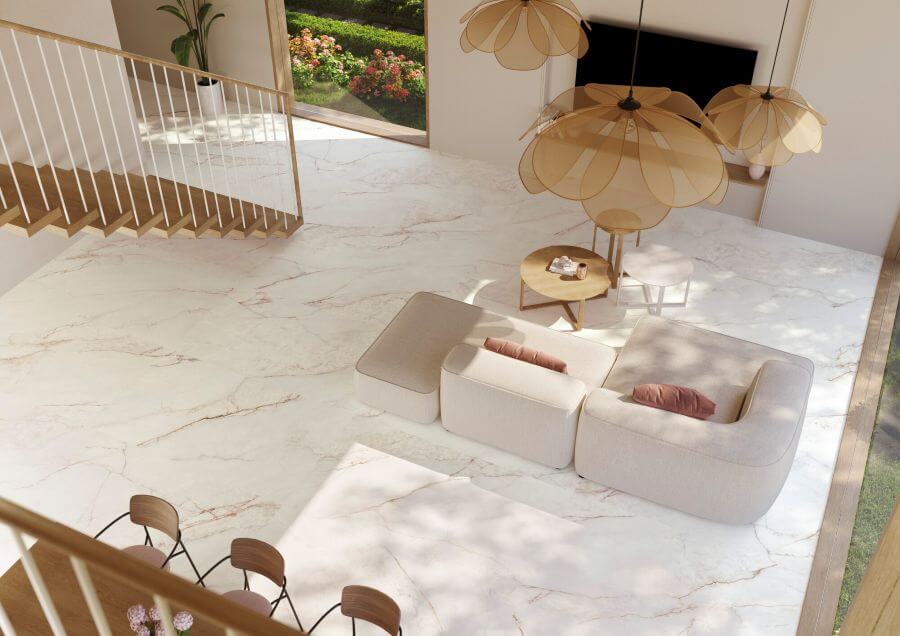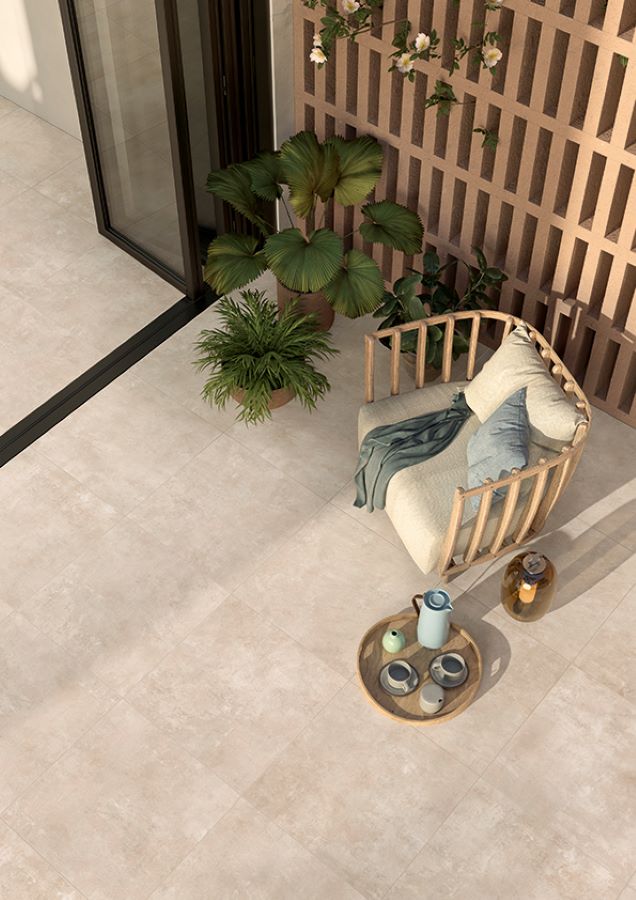
Porcelain vs ceramic tiles, which should you use where? Well, don’t judge a tile by its cover. On the surface, porcelain and ceramic tiles may look identical, but choosing the right tile material really is key to the success and longevity of your new space – whether that be a kitchen, living room or bathroom. This is because both porcelain and ceramic tiles share some material advantages, but they are also quite different. Both are made from clays, but a porcelain tile is made from a mix of clays and minerals. Both are fired at high temperatures, but porcelain tiles are fired at a higher temperature than ceramics. All this means that porcelain is the more hardwearing of the two, whereas ceramic tiles are easier to install. Let’s explore more.
Porcelain tiles
Porcelain tiles are extremely hard, dense, durable and pretty much waterproof. This means they are perfect for the everyday wear-and-tear you would expect in busy areas of the home like kitchens and bathrooms, and they can be used outside too because they are frost and fade resistant. However, they tend to cost more than ceramic tiles and because they are so dense they can be harder to cut. But porcelain tiles are super hardwearing!
Ceramic tiles
Ceramic tiles are a more budget-friendly option. They are not as hardwearing as porcelain tiles so they are better for low-traffic floors, walls or backsplash areas in a kitchen. One big advantage of ceramic tiles is they are lighter than porcelain tiles and therefore they are easier to cut and quicker to install.
As we said at the beginning of our blog, porcelain and ceramic tiles look near identical, so with a ceramic tile you will be getting a porcelain look at a ceramic price – just ensure you install them in an appropriate area.
Now we understand a little more about the key advantages of porcelain and ceramic tiles, let’s apply that to your own project.
The family bathroom – porcelain is a great choice for busy bathrooms. Porcelain tiles are highly water resistant and deal well with the humid conditions of bathrooms so you can use them with ease in the shower, around the bathroom and the bathroom floor. However, if budget is key, you could consider using porcelain for the floors and shower area and adding ceramic tiles to other parts of the bathroom. This also allows you to inject a different tile option.
The downstairs WC – similar to a busy bathroom, it is worth investing in porcelain tiles for the floor of your downstairs WC – you may even be running the same tile across your ground floor area anyway. This leaves you free to opt either for porcelain tiles or ceramic tiles for the walls.
Kitchens and kitchen splashbacks: investing in porcelain tiles for their durability and longevity in a high-moisture kitchen environment is worth it. This is the hardest working room in the home and porcelain is the obvious choice. Add to this food and drink spillages and with porcelain there is no need to worry about staining – so whilst it is always advisable to clear up spillages quickly for safety reasons, your tiles are highly unlikely to stain. With lots of moisture in the air from cooking, it is also worth thinking about porcelain for the splashback too.
The hallway: hallway floors can be well used if they are the main entrance to your home so porcelain tiles are a good option. Matt tiles in particular will cope with the heavy traffic and the likelihood of debris being dragged in on shoes from outdoor areas because porcelain tiles are highly scratch resistant. If you are looking to create a feature wall in the hallway, then a ceramic tile can be a great choice. With ceramic tiles available in an abundance of designs, it is easy to opt for something that is a little fun through pattern, colour or texture and really add the wow factor.
Outdoor spaces: porcelain tiles are essential for outdoor areas. Unlike ceramic tiles they are frost-resistant and come in finishes that make them suitable for external spaces. Porcelain is also fade resistant.
Budget friendly refurb: of course, if budget really is key then ceramic tiles can be more affordable than porcelain tiles. It’s just worth bearing in mind your ceramic floor tiles will need a little more care to keep them in tip top condition eg ceramic tiles are more prone to scratching than porcelain.
While porcelain and ceramic tiles are different, they’re not oil and water. You can mix them up in your project to achieve the perfect look.
Here, we’ll let you in on a little TilePortfolio secret:
The design options for both porcelain and ceramic tiles are plentiful. Let’s browse four TilePortfolio favourites:
Porcelain Styles
Ceramic Designs:
You really are spoilt for choice!
Here are five considerations to help you choose between porcelain or ceramic tiles for your space:
Conclusion: Porcelain vs Ceramic Tiles
As we have seen, choosing between porcelain vs ceramic tiles is all about understanding your own space. Do you want durable, hardwearing and low-maintenance porcelain tiles, or budget-friendly and decorative ceramic tiles to grace your walls and floors. By pairing the right tile with the right space, you can ensure your project not only looks gorgeous, but remains gorgeous too, and comes in at the right price.
Click the images to head straight to these tiles on our website. Working on a project? We’d love to help! Get in touch and let us start searching for beautiful tiles with you!
If you would like to know more, please get in touch...
The TilePortfolio specialise in Italian and Spanish Porcelain and Ceramic tiles, in particular large format Porcelains and Porcelain tiles for inside and outside. Our carefully curated, stunning tile portfolios are beautifully presented online and supported by our fuss-free ‘go-the-extra-tile’ service. In addition, you can view our entire tile collection at our Northamptonshire Showroom. Visit our website for unmissable interiors inspiration. The TilePortfolio team are always available to chat, we’d be delighted to help with your project so please do get in touch.
Please note: We strongly recommend using a professional tiler for your project. Installation requirements may vary depending on the tiles you choose, the fixing products used and the specific conditions. Always check with your tiler regards the suitability of the tiles. Please get in touch with us if you have any questions.
